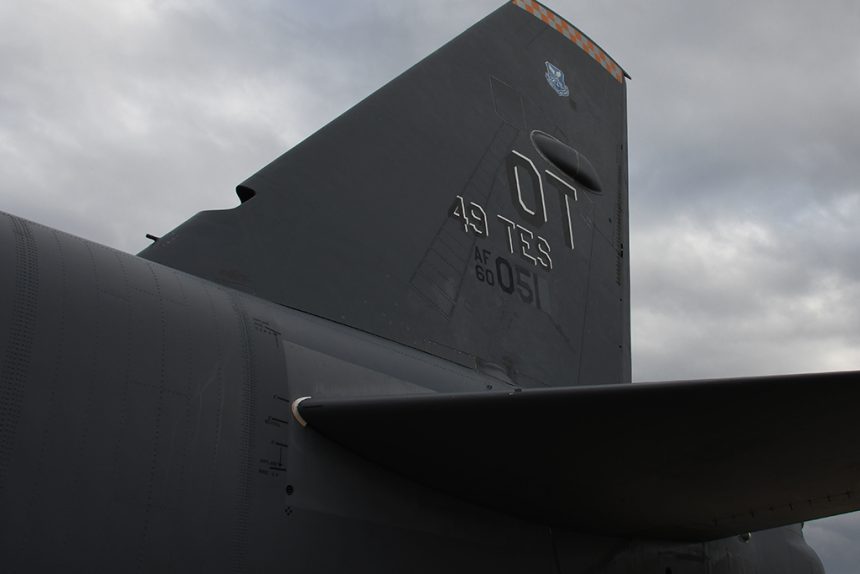A lightning struck a B-52 Stratofortress assigned to the 307th Bomb Wing upon final approach to Barksdale Air Force Base: the tail of the aircraft was damaged beyond repair.
On Dec. 19, 2017, B-52 Stratorfortress (60-0051), with the 93rd Bomb Squadron/307th BW AFRC was about to land at Barksdale AFB, La, when the crew heard something that sounded like a thud coming from the outside of the bomber. The aircraft landed safely, but once on the ground the crew discovered that the sound they heard was actually a lightning strike that tore a person-sized gash completely through the tail of the aircraft.
“Close encounters” between civil and military aircraft and lightnings occur every now and then around the globe.
In the 1980s, some F-16 Fighting Falcon jets were lost after being struck by lightinings. In one case, the lightning ignited the vapors in the empty centerline tank, which exploded causing extended damage to the aircraft’s hydraulic system.
Since lightning strikes are quite rare (1 event each year on average) these are seldom a real risk to military or civil aviation.
Furthermore, planes are shielded by a so-called Faraday Cage made by a conducting material, that blocks out external static electrical fields: charges redistribute on the conducting material and don’t affect the cage’s interior.
All commercial and mil planes have to meet several safety lightining-related requirements to get the airworthiness certifications required in the U.S. and Europe. For instance, they must be able to withstand a lightning strike without suffering significant airframe damage, without any possibility of accidental fuel ignition in the tanks and preserving the avionics and systems failures induced by the electromagnetic field created by the electrical charges of the lightning.

After assessing the damage, it was determined that the tail was damaged beyond repair and would have to be replaced: a large-scale, and uncommon, repair.
The B-52 is equipped with a lightning arrester designed to mitigate damage from lightning strikes, but this one was too strong even for the jet’s safeguards. “We see a handful of strikes every year, but out of all the maintainers we have, no one had seen lightning damage that bad,” said Lt. Col. George P. Cole, III, 307th Maintenance Squadron commander in a public release.
“I’ve been with the unit for fifteen years and this is the first time we have had to change a tail,” said Senior Master Sgt. Michael Nelson, 307th MXS flight maintenance superintendent. “We only had one other maintainer on our team that has ever changed one.”
According to the U.S. Air Force, Master Sgt. Eric Allison, 307th MXS B-52 aircraft mechanic, was the only maintainer on the eight person team with experience replacing a tail prior to the lighting strike. “It’s challenging because you have to position the tail just right and it is a two-thousand pound piece of metal,” he said. “It is like lining up the hinges when replacing a door,” said Tech. Sgt. David Emberton, 307th MXS B-52 aircraft mechanic. “You have to line it up correctly and the whole time it is twisting and flexing.”
Another possible obstacle was finding a replacement but instead of ordering it from the 309th AMARG (Aerospace Maintenance and Regeneration Group), the maintainers from the 307th Maintenance Squadron found that one tail was available from a retired jet.
“Having that tail on hand saved us a great deal of time because ordering it from AMARG would have taken months,” Nelson said.
So, the 307th MXS completed the works and made the B-52 available for flight operations in just a couple of weeks. Sporting a different tail reclaimed from another decommissioned B-52, still able to take to air again.
By the way, the Stratofortress has already proved it can fly with damages to the tail: actually, even with a detached vertical stabilizer, as happened 54 years ago, when a B-52H involved in a test flight lost its tail at about 14,000 feet over New Mexico. Six hours later, the civilian test pilot Chuck Fisher and his three-man crew managed to perform the first and only Stratofortress‘s tailless landing.
Image credit: U.S. Air Force









